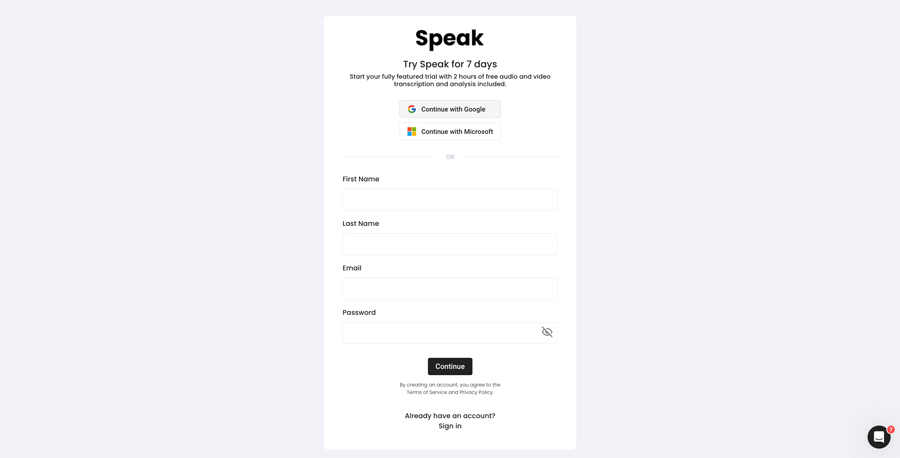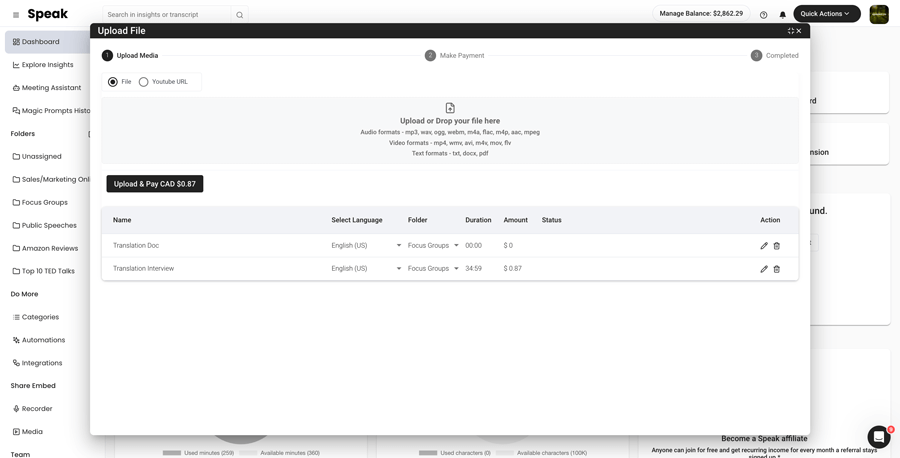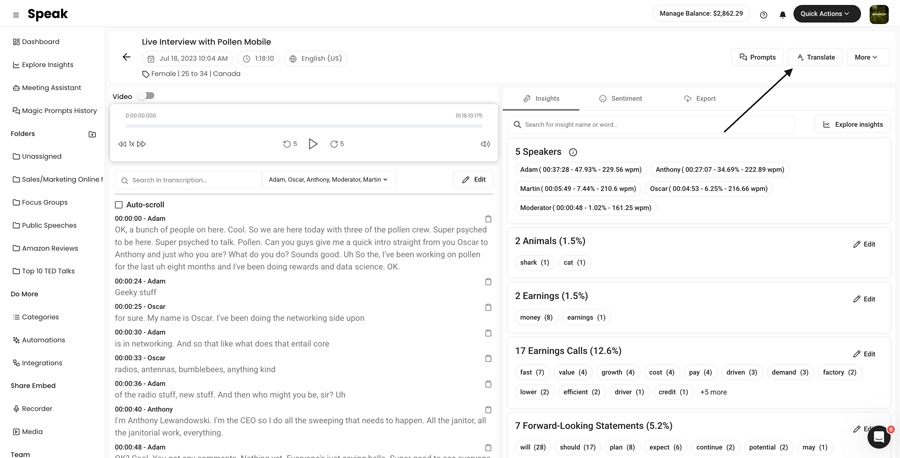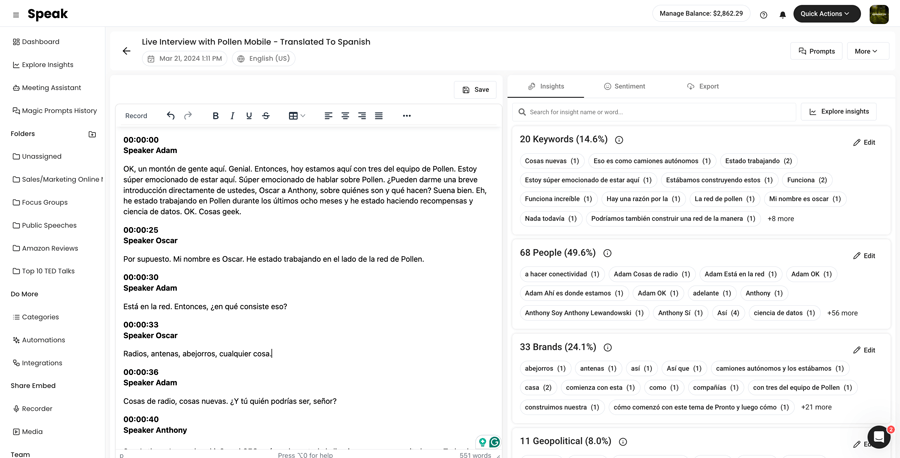How To Translate Chinese (Simplified) to Chinese (Cantonese, Traditional)
Translating Chinese (Simplified) to Chinese (Cantonese, Traditional) is super simple!

Step 1: Register for Speak
Register for Speak using this link.
Once you register, you can instantly begin translating your Chinese (Simplified) to Chinese (Cantonese, Traditional) file(s).

Step 2: Upload Your Chinese (Simplified) file(s)
As soon as you log in, you will be redirected to the dashboard.
Once there, you can select the Quick Action “New Upload”.
In Speak, you can seamlessly upload, transcribe and translate audio, video and text files all at once!

Step 3: Translate Your Chinese (Simplified) file(s) to Chinese (Cantonese, Traditional)
Once the file is uploaded, simply visit your file and select “Translate”.
If it is an audio and video file, Speak will ask you if you want to keep the speaker names and timestamps in the translation.
Want to translate many files at once? No problem!
You can view the files you want to automatically translate from Chinese (Simplified) to Chinese (Cantonese, Traditional) from the folder level and instantly translate as many files as you need with our artificial intelligence translation in just a few clicks.

Step 4: That’s It! View, Analyze, Modify & Export Your New Chinese (Cantonese, Traditional) file(s)
Once the translation is done, you will be alerted and you will see a new document in the same folder your original file is in.
The file will be named the same but with a dash indicating that it is the translated version.
Need support with your Chinese (Simplified) translation?
We are always here and happy to help at Speak!
Just send us a message on live chat on the bottom right corner and we will ensure you are set up for success.
Interested in translating Chinese (Simplified) or other languages to different languages? View our entire list of supported translation languages here.
Automatic, accurate, instant AI translation from Chinese (Simplified) to Chinese (Cantonese, Traditional) is here for you.
Register for Speak using this link and begin translating Chinese (Simplified) to Chinese (Cantonese, Traditional) today.
Unlocking the Power of Language: Translate Chinese (Simplified) to Chinese (Cantonese, Traditional)
In today’s fast-paced, global business environment, effective communication has never been more critical. With the rise of artificial intelligence and machine learning technologies, bridging linguistic barriers has become seamless and efficient. Particularly, the translation between Chinese (Simplified) and Chinese (Cantonese, Traditional) holds immense value for researchers, businesses, and everyday communication. Let’s delve into the transformative benefits and the innovative solutions offered by Speak AI to master these languages effortlessly.
The Strategic Importance of Chinese (Simplified) to Chinese (Cantonese, Traditional) Translation
Understanding the nuances between Chinese (Simplified) and Chinese (Cantonese, Traditional) can significantly impact your business strategies and research findings. This translation is not merely about converting text; it’s about preserving cultural significance, ensuring context accuracy, and enhancing engagement in the diverse Chinese-speaking world.
Automatic Translation: Time and Cost Efficiency
Embracing automatic translation leverages the sophisticated algorithms of AI to provide swift and accurate translations. This technology is revolutionizing how businesses operate, slashing the time and costs associated with traditional translation methods. Speak AI’s translation services epitomize efficiency, offering immediate turnaround times without compromising on quality.
Enhanced Communication and Market Reach
The ability to translate between Chinese (Simplified) and Chinese (Cantonese, Traditional) empowers businesses to broaden their market reach. It facilitates clear and effective communication with a vast audience, enabling companies to penetrate new markets and forge stronger connections with Chinese-speaking consumers and partners.
Optimizing Research Insights
For researchers, accurate translation is pivotal. Speak AI’s technology ensures that academic or market research materials are translated correctly, allowing for deeper insights and more reliable data analysis across linguistic boundaries. This precision is invaluable in a research context where every detail matters.
Leveraging Speak AI for Your Translation Needs
At Speak AI, we understand the intricate dynamics of language translation. Our software incorporates NLP, large language models, and generative AI to offer unparalleled translation services. Here’s how Speak AI is changing the game:
AI Meeting Assistant: Beyond Just Translation
Speak AI’s Meeting Assistant is not just a translator. It’s a comprehensive tool that joins online meetings, automatically transcribes, translates, and analyzes content in real-time. This innovative assistant supports various platforms like Microsoft Teams, Zoom, Google Meet, and Webex, making your meetings efficient and linguistically inclusive.
The Power of Automatic Analysis
With Speak AI, translation extends beyond mere words. Our platform offers automatic analysis through large language models, turning translated texts or speech into actionable insights. This feature is especially beneficial for businesses and researchers striving to understand trends, sentiments, and patterns within Chinese-speaking markets.
Trusted by Thousands
Our commitment to excellence is reflected in our 4.9 rating on G2 and a thriving user base of over 150K satisfied clients. Speak AI stands as a beacon of reliability and innovation in the translation industry, especially for complex translations like Chinese (Simplified) to Chinese (Cantonese, Traditional).
A Closer Look: Chinese (Simplified) and Chinese (Cantonese, Traditional)
Delving deeper, let’s explore the relevance, differences, and some intriguing facts about these two forms of the Chinese language.
Geographical and Demographic Presence
Chinese (Simplified) is predominantly used in Mainland China and Singapore, serving as the written standard for over a billion people. On the other hand, Chinese (Cantonese, Traditional) flourishes in Hong Kong, Macau, and among vast communities in the UK, Canada, and the USA, mirroring a rich diaspora and historical lineage.
Fascinating Linguistic Insights
- Chinese (Simplified) was introduced in the 1950s to promote literacy by reducing the number of strokes in characters.
- Chinese (Cantonese, Traditional) retains ancient character forms, offering a window into China’s historical and cultural depth.
Divergence and Convergence
While the two dialects share the same phonetic roots, their written forms diverge significantly. Simplified Chinese boasts fewer strokes and more modern characters, whereas Traditional Chinese offers a complex structure with historical essence. Despite their differences, both dialects convey the rich tapestry of Chinese culture and heritage.
Conclusion
Mastering the translation between Chinese (Simplified) and Chinese (Cantonese, Traditional) presents a gateway to unlocking vast opportunities in communication, business, and research. With Speak AI’s cutting-edge technology, embracing these opportunities has never been easier or more efficient. Experience the future of translation and let Speak AI be your partner in crossing linguistic frontiers with confidence and ease.
Join the Speak AI community today and transform your multilingual challenges into opportunities for growth and connection.
FAQ
What locations are Chinese (Simplified) and Chinese (Cantonese, Traditional) popular?
Chinese (Simplified) is widely used in Mainland China and Singapore, while Chinese (Cantonese, Traditional) is predominant in Hong Kong, Macau, and among Chinese communities in various countries around the globe.
What are some fun facts about Chinese (Simplified) and Chinese (Cantonese, Traditional)?
Chinese (Simplified) characters have fewer strokes than their Traditional counterparts, making them easier to learn and write. Meanwhile, Traditional Chinese characters offer a glimpse into China’s rich history and cultural heritage, being used in classical literature and formal documents in regions like Hong Kong and Macau.
What are the differences and similarities between Chinese (Simplified) AND Chinese (Cantonese, Traditional)?
The main difference lies in their character composition and usage, with Simplified Chinese having fewer strokes and Traditional Chinese preserving historical character forms. However, both serve as a bridge to China’s rich cultural legacy and are integral to the Chinese linguistic landscape.
Translate Chinese (Simplified) To These Other Supported Languages:
- Translate Chinese (Simplified)-to-Albanian
- Translate Chinese (Simplified)-to-Amharic
- Translate Chinese (Simplified)-to-Arabic (Egypt)
- Translate Chinese (Simplified)-to-Arabic (Iraq)
- Translate Chinese (Simplified)-to-Arabic (Israel)
- Translate Chinese (Simplified)-to-Arabic (Jordan)
- Translate Chinese (Simplified)-to-Arabic (Kuwait)
- Translate Chinese (Simplified)-to-Arabic (Lebanon)
- Translate Chinese (Simplified)-to-Arabic (Oman)
- Translate Chinese (Simplified)-to-Arabic (Palestinian Authority)
- Translate Chinese (Simplified)-to-Arabic (Qatar)
- Translate Chinese (Simplified)-to-Arabic (Saudi Arabia)
- Translate Chinese (Simplified)-to-Arabic (Syrian Arab Republic)
- Translate Chinese (Simplified)-to-Arabic (United Arab Emirates)
- Translate Chinese (Simplified)-to-Arabic Modern Standard (Bahrain)
- Translate Chinese (Simplified)-to-Armenian
- Translate Chinese (Simplified)-to-Azerbaijani
- Translate Chinese (Simplified)-to-Bengali
- Translate Chinese (Simplified)-to-Bosnian
- Translate Chinese (Simplified)-to-Bulgarian
- Translate Chinese (Simplified)-to-Catalan
- Translate Chinese (Simplified)-to-Chinese (Cantonese, Traditional)
- Translate Chinese (Simplified)-to-Chinese (Simplified)
- Translate Chinese (Simplified)-to-Chinese (Traditional)
- Translate Chinese (Simplified)-to-Croatian
- Translate Chinese (Simplified)-to-Czech
- Translate Chinese (Simplified)-to-Danish
- Translate Chinese (Simplified)-to-Dari
- Translate Chinese (Simplified)-to-Dutch
- Translate Chinese (Simplified)-to-English
- Translate Chinese (Simplified)-to-English (Australia)
- Translate Chinese (Simplified)-to-English (India)
- Translate Chinese (Simplified)-to-English (Ireland)
- Translate Chinese (Simplified)-to-English (New Zealand)
- Translate Chinese (Simplified)-to-English (Scottish)
- Translate Chinese (Simplified)-to-English (South African)
- Translate Chinese (Simplified)-to-English (United Kingdom)
- Translate Chinese (Simplified)-to-English (United States)
- Translate Chinese (Simplified)-to-Estonian
- Translate Chinese (Simplified)-to-Farsi (Persian)
- Translate Chinese (Simplified)-to-Finnish
- Translate Chinese (Simplified)-to-French
- Translate Chinese (Simplified)-to-French (Canada)
- Translate Chinese (Simplified)-to-Georgian
- Translate Chinese (Simplified)-to-German
- Translate Chinese (Simplified)-to-German (Swiss)
- Translate Chinese (Simplified)-to-Greek
- Translate Chinese (Simplified)-to-Gujarati
- Translate Chinese (Simplified)-to-Haitian Creole
- Translate Chinese (Simplified)-to-Hausa
- Translate Chinese (Simplified)-to-Hebrew
- Translate Chinese (Simplified)-to-Hindi
- Translate Chinese (Simplified)-to-Hungarian
- Translate Chinese (Simplified)-to-Icelandic
- Translate Chinese (Simplified)-to-Indonesian
- Translate Chinese (Simplified)-to-Irish
- Translate Chinese (Simplified)-to-Italian
- Translate Chinese (Simplified)-to-Japanese
- Translate Chinese (Simplified)-to-Kannada
- Translate Chinese (Simplified)-to-Kazakh
- Translate Chinese (Simplified)-to-Korean
- Translate Chinese (Simplified)-to-Latvian
- Translate Chinese (Simplified)-to-Lithuanian
- Translate Chinese (Simplified)-to-Macedonian
- Translate Chinese (Simplified)-to-Malay
- Translate Chinese (Simplified)-to-Malayalam
- Translate Chinese (Simplified)-to-Maltese
- Translate Chinese (Simplified)-to-Marathi
- Translate Chinese (Simplified)-to-Mongolian
- Translate Chinese (Simplified)-to-Norwegian
- Translate Chinese (Simplified)-to-Pashto
- Translate Chinese (Simplified)-to-Persian
- Translate Chinese (Simplified)-to-Polish
- Translate Chinese (Simplified)-to-Portuguese
- Translate Chinese (Simplified)-to-Portuguese (Brazilian)
- Translate Chinese (Simplified)-to-Portuguese (Portugal)
- Translate Chinese (Simplified)-to-Punjabi
- Translate Chinese (Simplified)-to-Romanian
- Translate Chinese (Simplified)-to-Russian
- Translate Chinese (Simplified)-to-Serbian
- Translate Chinese (Simplified)-to-Sinhala
- Translate Chinese (Simplified)-to-Slovak
- Translate Chinese (Simplified)-to-Slovenian
- Translate Chinese (Simplified)-to-Somali
- Translate Chinese (Simplified)-to-Spanish
- Translate Chinese (Simplified)-to-Spanish (Mexico)
- Translate Chinese (Simplified)-to-Swahili
- Translate Chinese (Simplified)-to-Swedish
- Translate Chinese (Simplified)-to-Tamil
- Translate Chinese (Simplified)-to-Telugu
- Translate Chinese (Simplified)-to-Thai
- Translate Chinese (Simplified)-to-Turkish
- Translate Chinese (Simplified)-to-Ukrainian
- Translate Chinese (Simplified)-to-Urdu
- Translate Chinese (Simplified)-to-Uzbek
- Translate Chinese (Simplified)-to-Vietnamese
- Translate Chinese (Simplified)-to-Welsh



